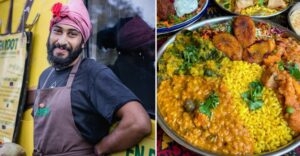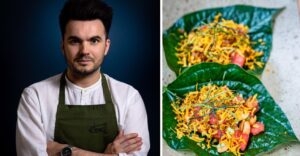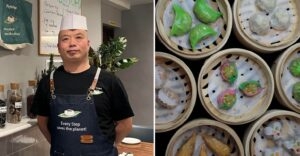Interview
Naturally vegan food from around the world: Chefs showing plant-based is nothing new
20 Jan 2023
8m
Here in the UK, you could say we’re in the middle of a vegan revolution, and that’s certainly no bad thing.
Plant-based meat substitutes are lining the shelves and we’re seeing everything from artificial chicken to pork to beef, with the vegan meat market expected to be worth $726.8 million (£589.6 million) by 2025.
But amongst all these amazing developments, we’re forgetting one important thing… vegan food existed long before soya and seitan and pea proteins. In fact, there are loads of cuisines that boast dishes that are naturally vegan, and have done for centuries.
From Indian cuisine to Thai and from Chinese to Ethiopian, we spoke to chefs about their plant-based go-tos, the naturally vegan dishes they’ve discovered throughout their careers and in some cases grew up with.
Tomi Makanjuola (The Vegan Nigerian) – Plant-based Nigerian food

Tomi and her vegan plantain porridge (Credit: Tomi Makanjuola)
You might not think of Nigerian food as obviously vegan food, and that’s because – basically – it isn’t.
“I grew up eating meat and never really questioned it,” says Nigerian chef Tomi, who has been vegan for about ten years. “Even Nigerians will tell you that a meal without meat is incomplete; lacking in something, but I went vegan in my 20s and it’s been really good to see minds changed over time.”
Whilst dishes like beef suya, Nigerian egg rolls and nkwobi (spicy cow foot) are staples, Tomi adds that, unbeknownst to a lot of people, there are “so many” dishes that are naturally plant-based, too, if you look a little deeper into the cuisine.
READ MORE: Your guide to going green for Veganuary
“That’s the interesting thing,” she says. “We’ve got lots of different porridges – we do bean porridge, yam porridge and breadfruit porridge – and all of those don’t contain meat in and of themselves, the meat is usually added on the side. We have things like jollof rice which can also be plant friendly if you’re using vegetable stock and we have things like moi moi which is a steamed bean pudding.”
Tomi says she draws a lot of inspiration from Nigerian snacks that are naturally vegan, too, like puff puff, which is a fried doughnut, and plantain chips.
“With vegan Nigerian food, sometimes people feel as though you’re taking something away,” Tomi adds. “Actually there’s a plethora of dishes and ingredients for you to experiment with.”
Nish Modasia (En Root) – Vegan Indian food

Nish owns plant-based Indian restaurants, En Root (Credit: En Root)
Nish grew up in Gujarat, which is the vegetarian state of India (primarily due to the 89 percent Hindi population).
“Food that I’ve been eating since forever include daals, curries, lentils and rice, all of which really celebrate vegetables and naturally process vegetables into really superb dishes,” says the founder of London’s En Root. “They’re flavour profiles you don’t necessarily identify towards vegan these days – people just think of burgers and [plant-based] fish and chips.”
Traditionally, a Gujarat daal is spicy and tangy and contains pigeon pea lentils. It’s a perfect example of a naturally vegan food that has been around for centuries, but there are so many variations across India, and indeed the world.
“I think we also need to remember that the majority of cultures that haven’t got money – for example, in South America, Asia, Africa – they’ve all got their rice and lentil bases. It’s all about survival, availability and abundance. Even in Europe, we’ve got all sorts of rice and lentil bases that we kind of disregard.
READ MORE: 8 brilliant vegan substitutes for every day baking
“I think when people move towards a state of having a bit more money, after the wars and things like that, they’ve just been forgotten. So, I feel a lot of joy about being able to eat what my ancestors did. In fact, I struggle to go a day without eating some sort of daal.”
Of course daal is just the tip of the iceberg. Most of us know how easy it is to go for a curry and not touch any meat at all.
“We’re in this kind of culture now we’re trying to mock and replicate, rather than just remembering that it’s all about the flavour, and those flavours already exist,” he says.
Andy Goodwin (Alter) – Global vegan street-food

Andy Goodwin with Thai yang leaf dish served at Alter (Credit: Alter)
As a chef, Andy had been working in global kitchens throughout his career, learning front stints in Asian restaurants like the infamous A Wong and Thai eatery, Som Saa. It was during his work at the latter, five years ago, that Andy went vegan himself.
“I was at Som Saa making this amazing Southern Thai satay curry that went on some grilled prawns, and the curry sauce was the best thing I’ve ever tasted in my entire life, and just happened to be completely vegan. I thought, why isn’t vegan food like this?”
From that thought came Alter – first a pop-up and now a fully fledged vegan restaurant – which has a focus “on what is gained, not lost” from plant-based food. Its whole ethos was exploring the naturally vegan foods found across global street food cultures, rather than recreating meaty dishes we’d all had before.
READ MORE: What do vegan chefs eat when they’re hungover?
“The first dish I created were these amazing Thai yang leaf bites, which are snacks from very rural settings where they use nettle leaf or betel leaf to wrap around a filling of some kind and there are a billion different variations. For Alter, we used kaffir lime salted watermelon with a fiery dry roasted coconut curry from Southern Thailand on top, then you add roasted peanuts and ginger and shallots and that’s wrapped up. It was an absolute explosion, and nobody had ever had anything like it.
“Elsewhere, we’ve got laksas (from Southeast Asia), we’ve got an amazing naturally vegan Biang biang noodle dish from the Xi-an region of China which pays homage to the fact they birthed pasta about 4000 years before the Italians did, and we’ve got a poached tofu dish served in Chengdu style Sichuan broth. We were keen to celebrate tofu not as a substitute but as it’s enjoyed in other parts of the world like Japan and China.”
“From day one of going vegan I was wondering, ‘why do we only want to replicate what we’ve had before and just tread water?’,” he says. “It’s mystifying to me that people aren’t looking to other cultures, and instead just taking away 88 percent of the things that we used to eat and trying to be satisfied with the other 12.
“It needn’t be that way at all. Eating vegan is a real chance to spread your wings, be more culturally curious and discover loads of new dishes.”
Helen Mebrate (Ethiopian Foodie) – Vegan Ethiopian food

Helen fronts up Ethiopian foodie (Credit: Helen Mebrate)
There are countless examples of naturally vegan dishes within Ethiopian cuisine, as Helen can attest.
“Generally speaking in Ethiopian culture, there wasn’t a lot of emphasis on eating meat,” says Helen, an Ethiopian foodie who runs a business named just that. “It was more seen as a luxury, and those that could afford it could. There’s also the religious elements. So, Orthodox Christians fast [on Wednesdays and Fridays throughout] the calendar year, and during this time, religion prohibits people from consuming animal products.”
Both of these factors led to Helen’s decision to go vegan six years ago, and whilst she grew up eating plant-based meals one or two days a week, she’s been discovering the sheer potential of her cuisine as a source of naturally vegan food ever since.
“There’s so much abundance in eating a fully wholesome, plant-based diet and it’s easy for me to say that because I come from the culture where there are so many dishes made from lentils, pulses and vegetables,” she says.
These make the basis of loads of stews like alicha wat (made of spiced yellow split peas and potatoes), shiro (made with chickpeas or broad beans) amongst many more, and are typically served with injera, which is a “fermented sourdough spongy bread”.
READ MORE: Vegetarian fast food demand is on the rise – and companies need to listen
“Then there’s vegetable dishes like cabbage, spring greens, kale, which are really simple to prepare and also affordable,” she adds.
“Being plant-based has a face and it can maybe intimidate people, because it’s synonymous with healthy eating and wealthy people. If you go on Instagram and look at some of the vegan foods, it’s like people are literally breaking their backs to create these dishes…but there is so much out there already.”
Kai Zou (Tofu Vegan) – Plant-based regional Chinese food

Kai Zou is chef at Tofu vegan (Credit: Tofu Vegan)
Kai Zou is head chef at Tofu Vegan, which comprises three completely plant-based Chinese restaurants in the heart of London.
You might be forgiven for thinking that Chinese food isn’t inherently vegan friendly, but as someone who is predominantly plant-based himself, he explains: “There is definitely a lot more vegetarian and vegan food in China than people realise.
“500 years ago, vegan dishes were very popular in China, but then the Chinese economy became so poor that people just ate anything. They’d grab anything to eat – any meat – and then we lost a lot of vegetarian and vegan dishes for the last few hundred years, but it’s picking up again.”
There’s also the fact that here in the UK,a lot of us think of Chinese cuisine specifically through the lens of Cantonese food, which can be quite meaty. But the chef says as more regional delicacies carry over, this is changing over time.
“We’re exploring regional vegan food from around China at Tofu Vegan, because there is a lot, and our aim is to bring more of that to the UK,” he says. “North east China has three different provinces where there’s a lot of different vegan food hailing from ancient times, for example.”
Di San Xian, for instance, is stir-fried aubergine, potatoes and peppers, whilst the Dongbei province also boasts glass noodle salads and barbecued mushroom dishes that don’t rely on meat at all.
Kai speaks fondly of eating a whole manner of vegan dishes growing up, including assorted vegetable dim sum (a staple across China) and smacked cucumber, which is also beloved the country over.
He also talks of delightfully numbing sichuan hotpots (which can be cooked with meat and fish, but are also easily enjoyed without, with an emphasis instead on vegetables, tofu and fungus to bulk them up.)
When you look deep into several popular Chinese dishes, you’ll realise there’s a vegan spin on it that has sometimes existed longer than the meaty version, he explains.
READ MORE: How to go vegan and live a plant-based lifestyle
“The sizzling tofu in special sauce, that’s taken from a north western recipe where you would usually expect pork. But actually, a long, long time ago, it would have been served vegetarian,” he says.
“[It’s all about] looking at the original recipes and reminding people of the vegetarian origins of these dishes.”

.jpg_RVG9qi?tr=w-2560,f-webp,q-70)
.png_2XIXGj?tr=w-2560,f-webp,q-70)
.jpg_qa3BF9?tr=w-2560,f-webp,q-70)